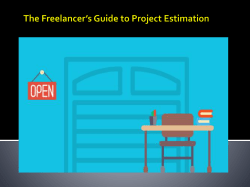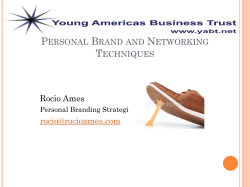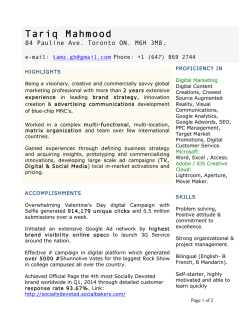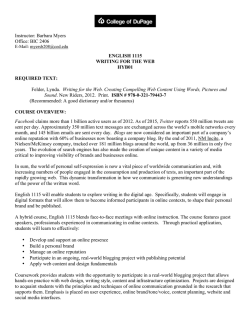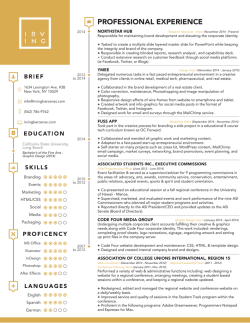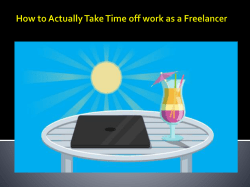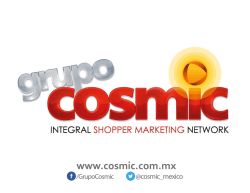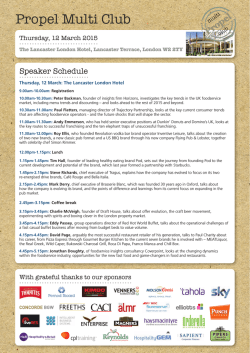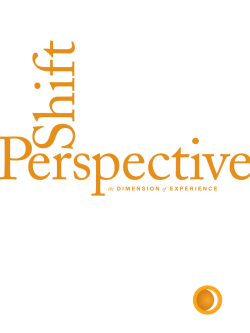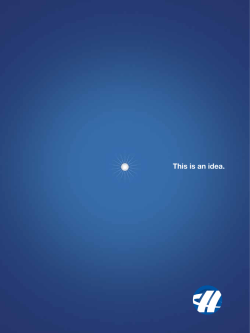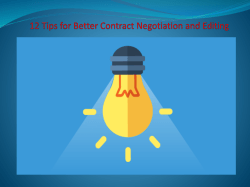
How to Brand Yourself and Get Your Freelancing Business out of the Garage
According to Freelancers Union’s 2015 “Freelancing in America” report, nearly 54 million people are freelancing in America. That’s 34% of the American workforce….54 million. Sure, when all of your friends are punching a clock, it’s easy to feel isolated and alone… but the truth is that you’re actually floating in a giant sea of similar workers, and a lot of them are your competition. Think of a ball pit (you know, those multi-colored pits of germs and fun?) the size of a football field. Now, imagine someone telling you to pick the best ball out of it. What would you do? If it were me, I’d probably look through the pile for about five minutes, and pick the best-looking one out of the group closest to me. People looking to hire a freelancer are put into the same position; they don’t have time to individually examine each qualified person for an extended period of time. They’re going to pick the one who stands out the most. So, what’s the defining factor between a successful freelancer and one who finally just decides to go back to his or her day job? Obviously, luck and talent have something to with it, but oftentimes the real difference comes with marketing and personal branding. You’ve got to put yourself out there if you want to get noticed. Clients are not going to hear your name on the wind and follow it to your doorstep. The thing about marketing is that you’ve got to have something to market, and when you’re freelancing, that can be a little difficult. How do you market yourself? You’re a person, not a big company! You may not be a corporation, and you are definitely a lone human, but as a freelancer, you’re also a brand. The water can get a little muddy and confusing when you start throwing out the word “brand.” Some people think a brand is a product, others think it’s your logo. I think the ever-wise marketing guru, Seth Godin, says it best: “A brand is the set of expectations, memories, stories and relationships that, taken together, account for a consumer’s decision to choose one product or service over another.” Everything that makes up the identity of your freelancing business is your brand… from the service or product you provide to the signature at the end of your emails. So how can personal branding bring you success? We’d love take a few moments to teach you how to market yourself right to the top of the giant ball pit that is the freelance life. Freelancing is not for the faint of heart. A successful freelancer is one who can bring in enough business to support him or herself, but without booking so many gigs that the quality of that work is diminished. The only way to pull that off is to have a solid identity; an unwavering feeling of what you stand for and value. You need to be able to get your name out and into the public in a way that’s recognizable and memorable. In other words, you’ve got to build yourself a brand, baby. Start with the basics and work your way up. What’s at the heart and soul of your freelance business? Why it’s you, you crazy kid. Your personal brand should be a clear blend of your talents, skills, and individuality. CLICK TO TWEET You want to showcase the services you provide while also highlighting something memorable about your personality. From here, you’ll be able to create a business name, find a catchy tagline to match it, and create an ecosystem of mission statements and branding merchandise that will hold you and your freelancing work above water. Michelle Schulp, WordPress designer, creative extraordinaire, and owner of Marktime Media, has crafted an extremely effective brand for herself. From her design and presentation prowess right up to her vibrant pink hair, she’s got a recognizable brand that works. She’s also got some great advice on getting started: “Your voice: who are you? What makes you awesome as a freelancer? Are you fun? Easy to talk to? Super smart and specialized? Relaxed? Obsessed with deadlines? How do you want people to interact with you? If you can put some thought into that part of it, everything else will start falling into place.” So, let’s start with you. You’ve got your home office, a handful of clients, and a few finished products that you’re especially proud of. This might not feel like a gigantic mountain of assets, but the truth is that you’ve got all you need to work on your personal branding. First, write down your creative process. I’m serious: write out the entire process as though you were explaining it to someone who doesn’t live inside your head. What parts of your process would seem appealing to potential clients? What tactics jump out at you? Are you extra-thorough? Do you employ surprising methods to reach your end-goal? Next, take a look at your portfolio. What are the common, positive factors shared by all of your finished projects? Choose a few descriptive words based on what you see in all of your past work and use them to build a personality for your brand. What are your strengths? What is unique to you? How can you craft an identity that communicates to a potential client what your skills are, and what sets you apart from others in your field? Focus on your clients. While representing yourself is important in personal branding, you’ve also got to keep your potential and current clients in mind. The meat of your brand has to revolve around the services you provide to the people who pay you money. This means you need to do some serious thinking about things like your mission statement, elevator pitch, and tagline. When it comes to naming your business, you can be as concrete or abstract as you want… as long as it matches your target audience. If you choose to take a more abstract route, you’ll need to ensure that the heart of your business and the services or products you provide are clear and easy to understand. This can be done through methods like elevator pitches or a tagline, which will help you stick to your creative decisions while communicating important information to your potential clients. Even if you choose to simply use your name as your brand, a tagline is especially important. Something as basic as your location and occupation can be enough to communicate just what it is that you do, but something catchy and creative is ideal. Take ApproveMe, for example. It’s a title that embodies what we do, but doesn’t say it explicitly. If you head to our website, however, you’ll see the headline “Use Your WordPress website to Sign Documents.” Clean and to the point. An elevator pitch is a way to succinctly explain the mission of your business in a compressed amount of time. Not only will this come in handy when you’re networking, but it will also force you to boil your ideas down to the basics. A mission statement will be longer and more thorough than an elevator pitch, and is great for the “About Me” or “Services” portion of your website. This will give you a chance to elaborate on how your services or product will not only serve your potential clients, but also set you apart from the competition. Gather your building materials and get visible. This is the part that can get overwhelming. There’s a small chance that you’re a branding or marketing expert, but there’s a bigger chance that you’re a different kind of freelancer who simply wants to get your name out there. How do you turn your brainstorming into branding reality? Michelle’s got more wisdom on this intimidating part of the branding process: “…the most important part of freelancing is people being able to get a hold of you, and seeing you’re good at what you do. So, you probably need a) a website, and b) some sort of thingy to give people when they meet you. But how much effort you put into that stuff depends on what you actually do for a living.” She goes on to explain that a web developer should focus on a clean website that showcases their coding abilities rather than worrying too much about impeccable graphic design, and a writer might be better off with a template that allows them to concentrate on the words they fill it with. So what about you? A website with a recognizable logo would be a good start, along with a few things that get people to that website. Look at your business and your audience to decide what would work best for you. Business cards? TShirts? Stickers? Skywriting? Bottom line: evaluate your business so that you don’t waste money on unnecessary marketing materials. A few tips: -Market within your means. Remember, you’re building a brand. If you can’t afford a super-fancy custom website right now, find a satisfying WordPress theme and make it work for you. -There’s no shame in using your name. If you simply can’t come up with a good business name, it’s okay; it’s better to use your name than picking something on the fly that you’ll regret later. It’s a good idea to buy a domain with your name anyway, so that you can use it to redirect people to your official URL if you think of something later on. -Pick your best traits and push them. Take a look at yourself, your process, and your work. Write down all the descriptive words you can think of that consistently crop up in this reflection and weave them into the fabric of your personal brand. -Ask satisfied clients for testimonials. Potential clients are especially interested in what former clients have to say about you, and the satisfied clients who love you the most will be more than happy to provide a positive testimonial. -Give a blog a chance. It’s rare to encounter a business that won’t benefit from a blog. It’s a good way to provide brand-related information to your followers and keep you visible, all while boosting your page’s SEO through frequent fresh content. -Find your favorite freelance resource. For more help with branding and freelancing in general, Michelle suggests Freelancers Union, Envato Blogs, andBidsketch Blog. (We, of course, have to throw ApproveMe’s growing freelance blog into the hat of resources, as well.) A solid brand will set you apart and push you to the top. Having a defined brand when you’re freelancing shows that you’re invested in your business, and that’s a trait that instills confidence in potential clients. If you can learn how to brand yourself and collect enough of that confidence, you’ll be working away for years to come. Who knows, maybe you’ll be able to buy yourself your own damned ball pit one of these days. Article Resource: https://www.approveme.com/freelancing/brand-get-freelancingbusiness-garage/
© Copyright 2025
